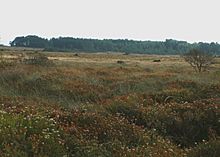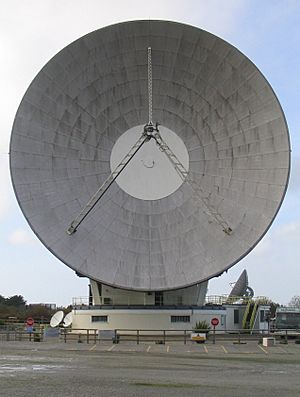Goonhilly Downs facts for kids
| Site of Special Scientific Interest | |

Goonhilly Downs
|
|
| Area of Search | Cornwall |
|---|---|
| Coordinates | 50°02′22″N 5°10′15″W / 50.0394°N 5.1709°W |
| Interest | Biological |
| Area | 1,271 hectares (12.7 km2; 4.91 sq mi) |
| Notification | 1951 |

Goonhilly Downs is a special natural area in Cornwall, England. It is a raised, flat area located on the Lizard peninsula in the southwest of the UK. This place is famous for its large Goonhilly Satellite Earth Station. This station was once the biggest of its kind in the world. The huge satellite dishes are easy to spot from far away.
Goonhilly Downs is also home to a large wind farm. It has six wind turbines that create 12 megawatts of power. The downs are also known for their unique plants and ancient history.
Contents
Goonhilly Satellite Station
The Goonhilly Satellite Earth Station is a very important part of Goonhilly Downs. It used to be the largest satellite station on Earth. The giant satellite dishes here are a famous sight. They help send and receive information from space.
Connecting the World
These dishes play a big role in how we communicate globally. They help with phone calls, internet, and TV signals. One of the longest underwater cables, called SEA-ME-WE 3, also connects to Goonhilly Downs. This cable helps carry internet data across the world's oceans.
Nature and Wildlife
Goonhilly Downs is a special place for nature. It is a Site of Special Scientific Interest (SSSI). This means it is protected because of its unique plants and animals.
Unique Plants
The area is mostly heathland. This type of land has tough, low-growing plants. The soil here is made from a special rock called serpentinite. This unique soil helps rare plants grow. One famous plant is the Cornish heath. It is the official flower of Cornwall.
North Predannack Downs Nature Reserve
Close to Goonhilly Downs is the North Predannack Downs Nature Reserve. The Cornwall Wildlife Trust manages this reserve. It has more Cornish heath and small ponds. You can also find willow fen areas here.
Animals of the Downs
This reserve is home to different animals. You might see the adder, which is a type of venomous snake. The stonechat, a small passerine bird, is also common here.
Ancient History
Goonhilly Downs has signs of people living there long ago. These signs tell us about its past.
Standing Stones and Barrows
You can find a large menhir on the downs. A menhir is a tall, ancient stone. It stands near the satellite station. In the North Predannack Downs, there are also Bronze Age barrows. These are ancient burial mounds. There are also old "turf-hut" circles, which were homes long ago.
World War II Remains
Some old buildings from the Second World War are also on the downs. These were part of RAF Dry Tree and RAF Trelanvean.
Images for kids


